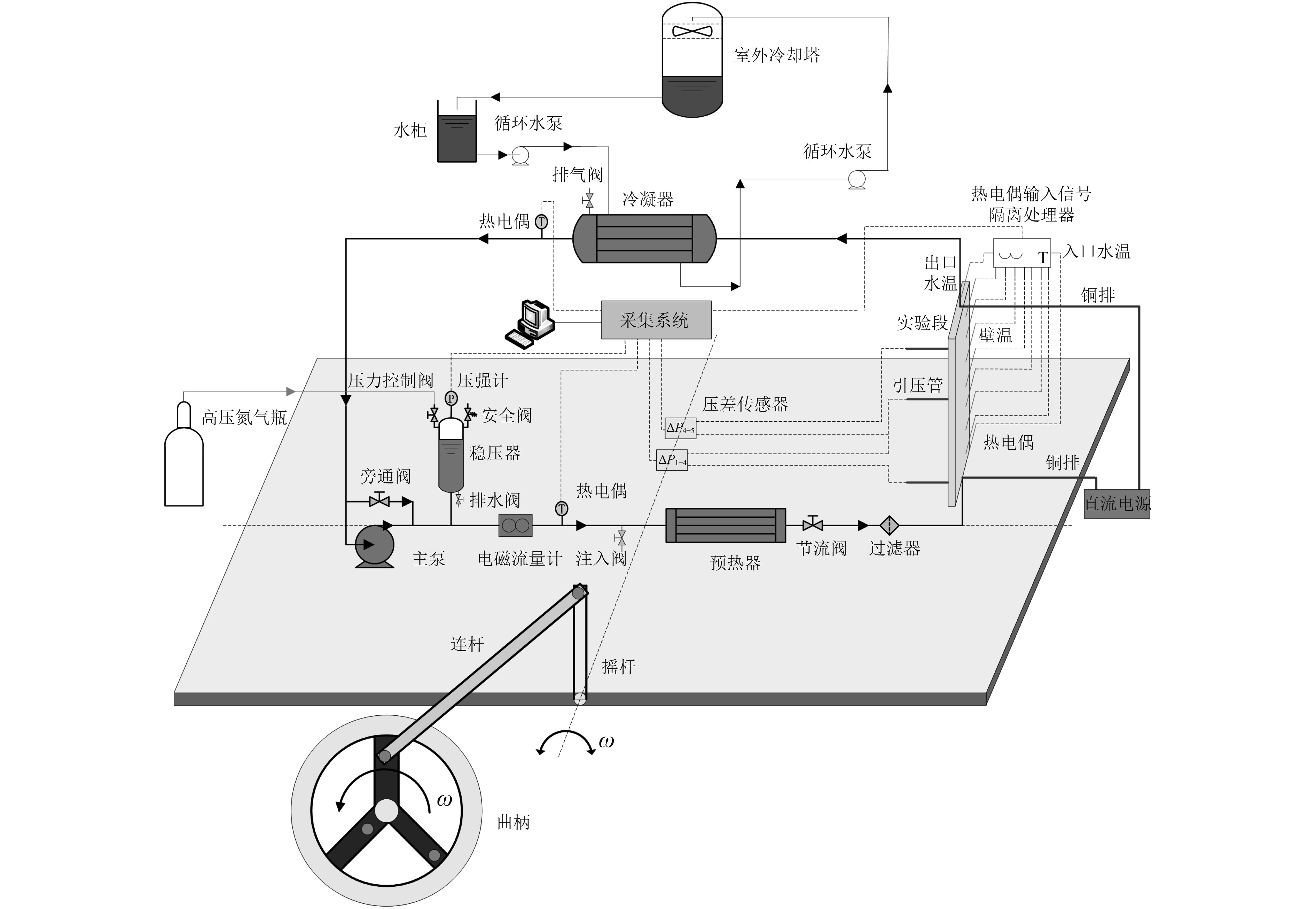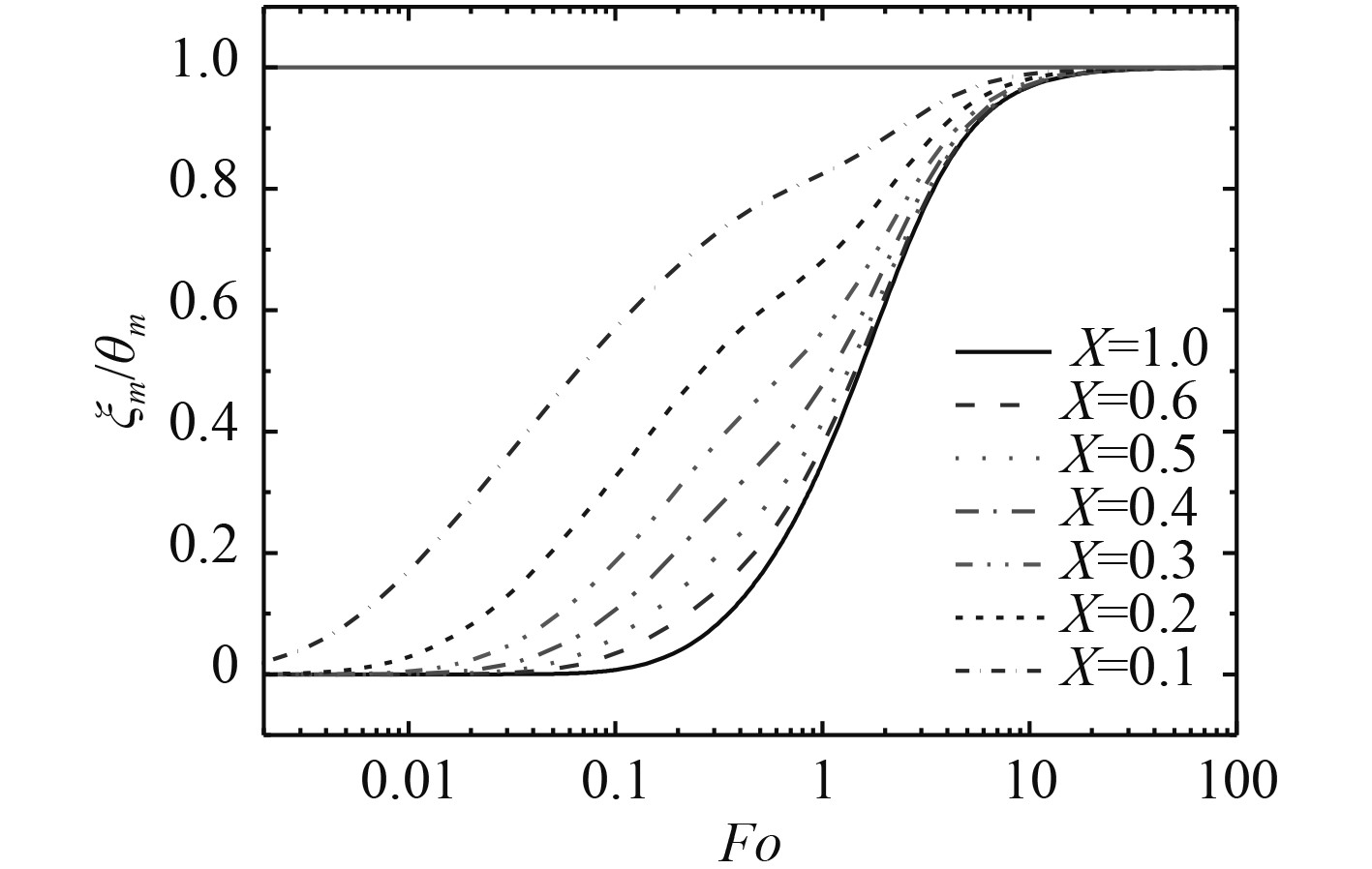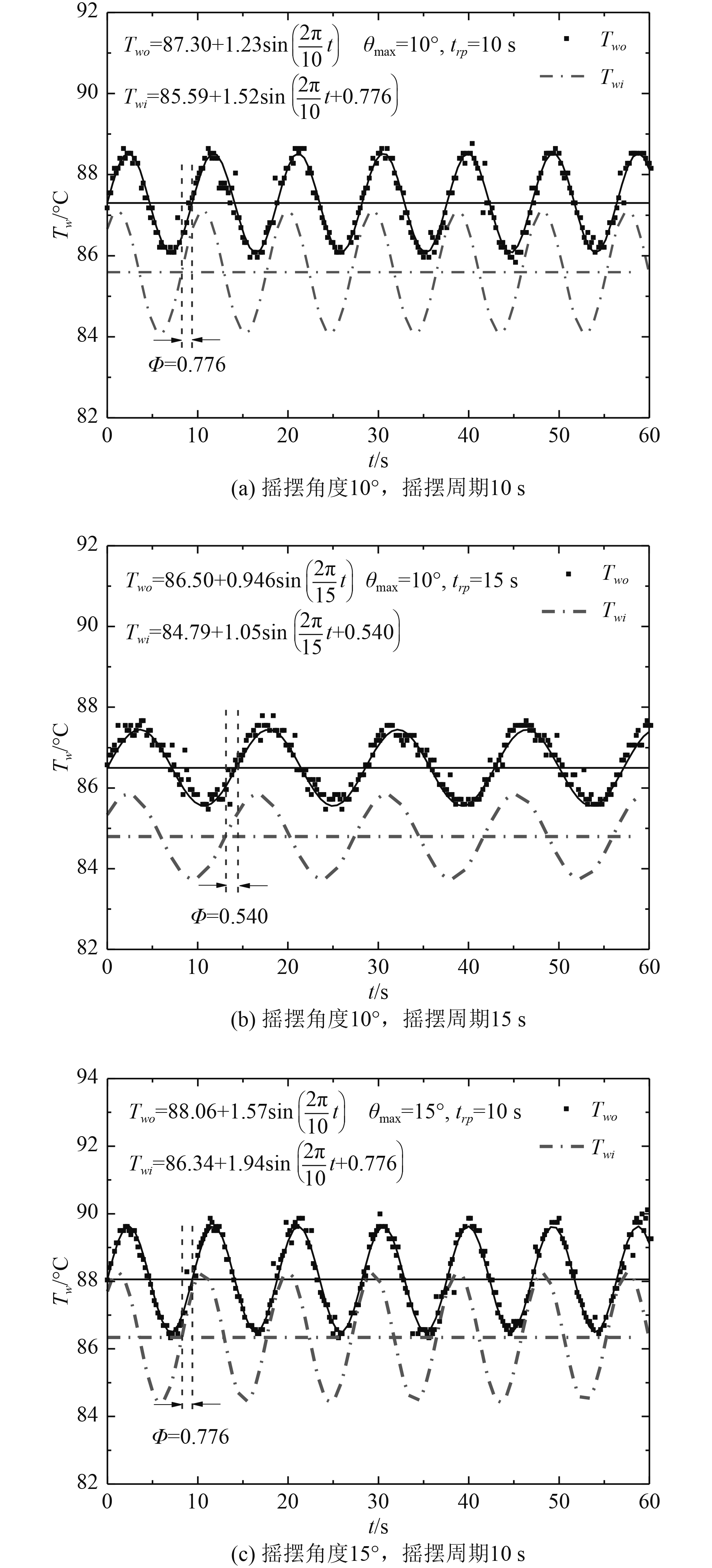核动力船舶或浮动式核动力平台在海洋上航行时会受到风浪的影响而产生一系列船舶摇摆、起伏、倾斜等运动[1-5],在海洋环境中船舶的摇摆、起伏等运动会引起矩形换热器或者堆芯热工水力特性的周期性波动,而温度的波动特性尤为显著。同时为提高船舶的空间利用率和体功率密度,船用换热器逐步向小型化、紧凑化的方向发展,而窄矩形通道拥有单位体积换热面积大、换热效率高等优点,窄矩形换热器将得到越来越多的重视,并逐渐应用到船舶领域[6-9]。Wang[10-11],Xing[12-13],Yan[14]通过热工实验研究表明,在海洋摇摆条件下系统回路内的流量会出现周期性的波动,并随着摇摆角度和摇摆频率的增加,系统内流量波动的振幅越大。系统流量的波动将引起矩形换热器内温度的周期性波动,使窄矩形通道内、外壁面温度波动特性不同,导致海洋条件下和稳态工况下数据处理的方法不同,在计算通道换热系数时,必须考虑内、外壁面温度的相位差。
为了更好研究海洋条件下矩形换热器窄矩形通道内壁面的温度波动特性和给出非稳态工况下窄矩形通道内壁面温度的计算方法,本文针对2 mm×40 mm的窄矩形通道进行了一系列的热工水力实验研究和理论分析。
1 实验装置海洋环境模拟实验装置如图1所示,实验装置由主实验回路、辅助实验回路、数据测量系统和海洋环境模拟台组成,海洋环境模拟台可实现最大摇摆角度20°和最小摇摆周期10 s的船舶摇摆运行。主实验回路主要用于测量矩形换热器窄矩形通道在海洋环境下的质量流量、壁面温度等参数的变化规律;辅助实验回路主要用于冷却主实验回路内的流体,实现实验的可持续运行。窄矩形通道的内尺寸为2 mm×40 mm,长度为1100 mm。采用低压直流电源对窄矩形通道进行加热,最大加热功率为90 kW。

|
图 1 海洋环境模拟实验装置 Fig. 1 Experiment device of marine environment simulation |
海洋环境模拟实验装置的流量由电磁流量计进行测量,其测量误差在±0.3 %以内;窄矩形通道的外壁面温度由一系列N型热电偶进行测量,测量误差在±0.2 ℃以内。
海洋环境模拟台通过调整曲柄长度和三相异步电机的频率,可实现摇摆角度和摇摆周期的控制,其控制方程为:
| ${\theta _t} = {\theta _{\max }}\sin \left( {{{2{\text{π}} } / T}} \right)\text{,}$ | (1) |
| ${\omega _t} = \frac{{2{\text{π}} }}{T}{\theta _{\max }}\cos \left( {{{2{\text{π}} t} / T}} \right)\text{,}$ | (2) |
| ${\beta _t} = - {\left( {\frac{{2{\text{π}} }}{T}} \right)^2}{\theta _{\max }}\sin \left( {{{2{\text{π}} t} / T}} \right)\text{。}$ | (3) |
式中:θt,ωt,βt,θmax和T分别为海洋环境模拟台的摇摆角度、角速度、角加速度、最大摇摆角度和摇摆周期。
2 海洋工况下壁面温度理论计算海洋条件下系统体积流量Q和窄矩形通道外壁面温度Two的波动特性如图2所示。船舶在海洋条件下系统内的流量会发生周期性波动,系统流量的波动会导致窄矩形通道内壁面温度的周期性波动,从而引起外壁面温度的周期性波动。在实验过程中热电偶测量的都是外壁面的温度波动特性,由于不锈钢材质具有一定的蓄热效应,使热量在材质中周期性的聚集和传导,导致在壁面温度波动过程中不能使用稳态导热方程求解内壁面温度,需采用非稳态方程进行解析。为进一步研究在海洋条件下窄矩形通道壁面温度的波动特性,建立窄矩形通道壁面温度波动的理论模型。

|
图 2 海洋条件下系统流量和壁面温度的变化 Fig. 2 Variation of mass flux and wall temperature under ocean conditions |
图3为海洋条件下窄矩形通道壁面温度波动的示意图,假设壁面温度是正弦周期性波动,窄矩形通道内、外壁面温度非稳态计算方程组如下:

|
图 3 海洋条件下壁面温度波动示意图 Fig. 3 Schematic diagram of wall temperature fluctuation under ocean conditions |
| $\left\{ \begin{array}{l} a\dfrac{{{\partial ^2}T}}{{\partial {x^2}}} + \dfrac{\eta }{{{\rho _w}{C_{pw}}}} = \dfrac{{\partial T}}{{\partial t}} \text{,}\\ T(0,t) = {T_{wis}} + {T_{wiA}}\sin \left( {\omega {\rm{t}}} \right),{\rm{ }}{\left. { - k\dfrac{{\partial T}}{{\partial x}}} \right|_{x = \delta }} = 0 \text{,} \\ T\left( {x,0} \right) = {T_{wis}} + \dfrac{{\delta \eta }}{k}x - \dfrac{\eta }{{2k}}{x^2} \text{。} \end{array} \right.$ | (4) |
式中:η,T,ρw,k,Twis,TwiA分别为实验通道体积释热率,W/m3;壁面温度,℃;实验通道不锈钢材料密度,kg/m3;不锈钢导热系数,W/(m℃);内壁面温度波动时均值,℃;内壁面温度波动振幅,℃。
为求解非齐次方程(4),对方程组进行无量化处理。
| $\theta = \frac{{T - {T_{wis}}}}{{{{\eta {\delta ^2}} / k}}},{\rm{ }}\tau = \frac{t}{{{T_0}}},{\rm{ }}X = \frac{x}{\delta },{\rm{ }}Fo = \frac{{a{T_0}}}{{{\delta ^2}}}\text{,}$ | (5) |
式中,T0为摇摆周期,s。
| $\left\{ \begin{array}{l} \dfrac{{{\partial ^2}\theta }}{{\partial {X^2}}} - \dfrac{1}{{Fo}}\dfrac{{\partial \theta }}{{\partial \tau }} = - 1\text{,} \\ \theta \left( {0,t} \right) = {\theta _m}\sin \left( {2{\text{π}} \tau } \right),{\rm{ }}{\left. {\dfrac{{\partial \theta }}{{\partial \tau }}} \right|_{X = 1}} = 0 \text{,}\\ \theta \left( {X,0} \right) = X - \dfrac{{{X^2}}}{2} \text{,} \end{array} \right.$ | (6) |
| ${\theta _m} = \frac{{{T_{wiA}}}}{{{{\eta {\delta ^2}} / k}}}\text{,}$ | (7) |
将式(6)齐次化,令
| $u = \theta + \frac{{{X^2}}}{2}\text{,}$ | (8) |
则式(6)变为:
| $\left\{ \begin{array}{l} \dfrac{{{\partial ^2}u}}{{\partial {X^2}}} = \dfrac{1}{{Fo}}\dfrac{{\partial u}}{{\partial \tau }} \text{,} \\ u\left( {0,\tau } \right) = {\theta _m}\sin \left( {2{\text{π}} \tau } \right),{\rm{ }}{\left. {\dfrac{{\partial u}}{{\partial X}}} \right|_{X = 1}} = 1 \text{,} \\ u\left( {X,0} \right) = X \text{,} \end{array} \right.$ | (9) |
可得:
| ${T_w}\left( {X,\tau } \right) = {T_{wis}} + \left( {X - \frac{{{X^2}}}{2}} \right)\frac{{\eta {\delta ^2}}}{k} + {\xi _m}\frac{{\eta {\delta ^2}}}{k}\sin \left( {\omega \tau + \varPhi } \right)\text{,}$ | (10) |
| ${\xi _m} = \sqrt {{{\left( {{\theta _m} + C} \right)}^2} + {D^2}} \text{,}$ | (11) |
| $C = \sum\limits_{n = 0}^\infty {\frac{{B\omega \sin \left( {{\beta _m}X} \right)}}{{{A^2} + {\omega ^2}}}} ,{\rm{ }}D = \sum\limits_{n = 0}^\infty {\frac{{AB\sin \left( {{\beta _m}X} \right)}}{{{A^2} + {\omega ^2}}}} \text{,}$ | (12) |
| ${\beta _m} = \frac{{\left( {2n + 1} \right){\text{π}} }}{2}\text{,}$ | (13) |
| $A = \beta _m^2Fo,{\rm{ }}B = - \frac{{8{\theta _m}}}{{2n + 1}},{\rm{ }}\omega = 2{\text{π}} \text{,}$ | (14) |
| $\left\{ \begin{array}{*{20}{l}} {{\theta _m} + C >0 ,}& \varPhi = \arctan \dfrac{D}{{{\theta _m} + C}} \text{,} \\ { D > 0,} &\varPhi = \dfrac{{\text{π}} }{2} - \arctan \dfrac{{{\theta _m} + C}}{D} \text{,} \\ {{\theta _m} + C < 0,D < 0,}&\varPhi = - {\text{π}} + \arctan \dfrac{D}{{{\theta _m} + C}} \text{。} \end{array} \right.$ | (15) |
式中:θm为不锈钢窄矩形通道内壁面温度无量纲波动振幅;ξm为外壁面温度无量纲波动振幅;Φ为温度波动的相位差,rad。
根据以上理论计算结果,式(10)给出了海洋条件下壁面温度的波动方程,可以看出在海洋工况下内、外壁面温度呈现有规律的周期性波动,同时不同相对位置壁面温度的波动振幅和相位差均不同,同时均与傅里叶数Fo有关。
3 理论分析与实验研究窄矩形通道内、外壁面温度波动的相位差和相对波动振幅的变化规律如图4和图5所示。X=1.0表示此时的相位差曲线或者相对波动振幅曲线为内、外壁面温度的波动特性曲线,随着傅里叶数的增加或者相对内壁面距离的减小,内外壁面温度波动的相位差逐渐减小,而相对波动振幅逐渐增加,也就是说如果热扰动在材质中能够快速的传播或者壁面很薄,内外壁面温度的波动曲线将逐渐趋于一致。从图4还可以看出,外壁面温度波动的相位延迟于内壁面温度波动的相位,且随着傅里叶数的增加相位差的相对变化率逐渐减小,也就是说在低傅里叶数区域通过增加热物性、减小壁厚等措施能够较好的减小内外壁面温度波动的相位差,可以较好地减弱热应力的交变速率。从图5还可以看出,随着傅里叶数的增加,内外壁面相对波动振幅的增加分3个区域,其中傅里叶数在0.1~10区间时,壁面相对波动振幅增加的相对变化率明显较大。

|
图 4 壁面温度波动相位差的变化规律 Fig. 4 Variation of phase difference of wall temperature fluctuation |

|
图 5 壁面温度相对波动振幅的变化规律 Fig. 5 Variation of relative fluctuation amplitude of wall temperature |
根据以上的理论分析,对海洋条件下窄矩形通道内壁面温度波动特性曲线进行理论计算,窄矩形通道内、外壁面温度波动特性曲线如图6所示。外壁面温度为传感器实测值,内壁面温度为采用非稳态传热公式的计算值,从图中可以看出内壁面温度时均值低于外壁面温度时均值,而内壁面温度波动振幅大于外壁面温度波动振幅。针对相同摇摆角度不同摇摆周期的工况,内外壁面温度波动的相位差不同,且摇摆周期越大相位差越小;针对相同摇摆周期不同摇摆角度的工况,内外壁面温度波动的相位差相同,也就是说在通道材质、厚度等参数相同的情况下,内、外壁面温度波动的相位差只与摇摆周期有关,与摇摆振幅无关。

|
图 6 内、外壁面温度变化规律 Fig. 6 Variation of inside and outside wall temperature |
通过海洋条件下对矩形换热器窄矩形通道壁面温度特性的理论分析和实验研究,得出如下结论:
在海洋条件下矩形换热器窄矩形通道内、外壁面温度随着摇摆运动而产生周期性波动,且内、外壁面温度波动特性曲线存在相位差,内壁面温度波动时均值低于外壁面温度,而内壁面温度波动的振幅大于外壁面温度。随着傅里叶数的增加,内外壁面温度波动的相位差逐渐减小,而相对波动振幅逐渐增加。在通道材质、厚度等参数相同的情况下,窄矩形通道内、外壁面温度波动的相位差只与摇摆周期有关,与摇摆振幅无关。最后本文给出了在海洋条件下壁面温度计算的非稳态导热公式,为窄矩形通道温度分布特性的研究和换热特性的研究提供准确的支撑。
| [1] |
高璞珍, 张文超, 谭思超, 等. 摇摆条件下自然循环复合型脉动的同步化分析[J]. 哈尔滨工程大学学报, 2012, 33(11): 1346-1350. GAO Pu-zhen, ZHANG Wen-chao, TAN Si-chao, et al. Synchronization analysis of natural circulation complex pulsation under rolling motion[J]. Journal of Harbin Engineering University, 2012, 33(11): 1346-1350. |
| [2] |
高璞珍, 庞凤阁, 王兆祥. 核动力装置一回路冷却剂受海洋条件影响的数学模型[J]. 哈尔滨工程大学学报, 1997, 18(1): 26-29. GAO Pu-zhen, PANG Feng-ge, WANG Zhao-xiang. Mathematical model of primary coolant in nuclear power plant influenced by ocean conditions[J]. Journal of Harbin Engineering University, 1997, 18(1): 26-29. |
| [3] |
高璞珍, 庞凤阁, 刘殊一, 等. 倾斜对强迫循环和自然循环影响的比较[J]. 哈尔滨工程大学学报, 1997, 17(2): 88-92. GAO Pu-zhen, PANG Feng-ge, LIU Su-yi, et al. Effects of listing upon forced circulation and natural circulation[J]. Journal of Harbin Engineering University, 1997, 17(2): 88-92. |
| [4] |
王占伟. 摇摆运动下冷却剂低流速流动、传热特性研究[D]. 哈尔滨: 哈尔滨工程大学, 2013. WANG Zhan-wei. The flow and heat transfer characteristics for low flow rate flow under rolling motion conditions[D]. Harbin: Harbin Engineering University. 2013. |
| [5] |
吕路路. 摇摆运动下窄矩形通道内沸腾换热特性实验研究[D]. 哈尔滨: 哈尔滨工程大学, 2013. LV Lu-lu. Experimental research for effect of rolling motion upon the characteristics of flow boiling heat transfer[D]. Harbin: Harbin Engineering University. 2013. |
| [6] |
Lee Han Ju, Lee Sang Yong. Heat transfer correlation for boiling flows in small rectangular horizontal channels with low aspect ratios[J]. International Journal of Multiphase Flow, 2001, 27(2001): 2043-2062. |
| [7] |
幸奠川. 摇摆对矩形通道内流动阻力特性的影响研究[D]. 哈尔滨: 哈尔滨工程大学, 2013. XING Dian-chuan. Investigations on effects of rolling motion on characteristics of flow resistance in rectangular duct[D]. Harbin: Harbin Engineering University. 2013. |
| [8] |
Sobierska EWELINA, Kulenovic RUDI, Mertz RAINER, et al. Experimental results of flow boiling of water in a vertical microchannel[J]. Experimental Thermal and Fluid Science, 2006, 31(2): 111-119. DOI:10.1016/j.expthermflusci.2006.03.022 |
| [9] |
MAHMOUD MOHAMED M., KARAYIAMMIS TASSOS G. Heat transfer correlation for flow boiling in small to micro tubes[J]. International Journal of Heat and Mass Transfer, 2013, 66(2013): 553-574. |
| [10] |
WANG C, WANG S W, WANG H, et al. Investigation of flow pulsation characteristic in single-phase forced circulation under rolling motion[J]. Annals of Nuclear Energy, 2014, 64(2014): 50-56. |
| [11] |
WANG C, LI X H, WANG H, et al. Experimental study on friction and heat transfer characteristics of pulsating flow in rectangular channel under rolling motion[J]. Progress in Nuclear Energy, 2014, 71(2014): 73-81. |
| [12] |
XING D C, YAN C Q, SUN L C, et al. Effect of rolling motion on single-phase laminar flow resistance of forced circulation with different pump head[J]. Annals of Nuclear Energy, 2013, 54(2013): 141-148. |
| [13] |
XING D C, YAN C Q, SUN L C, et al. Frictional resistance of adiabatic two-phase flow in narrow rectangular duct under rolling conditions[J]. Annals of Nuclear Energy, 2013, 53(2013): 109-119. |
| [14] |
YAN B. H., GU H. Y., YANG Y. H., et al. Effect of rolling on the flowing and heat transfer characteristic of turbulent flow in sub-channels[J]. Progress in Nuclear Energy, 2011, 53(1): 59-65. DOI:10.1016/j.pnucene.2010.09.003 |
 2021, Vol. 43
2021, Vol. 43
